- Scientific name: Carex baileyi Britton
- Species of Greatest Conservation Need (MA State Wildlife Action Plan)
- Threatened (MA Endangered Species Act)
Description
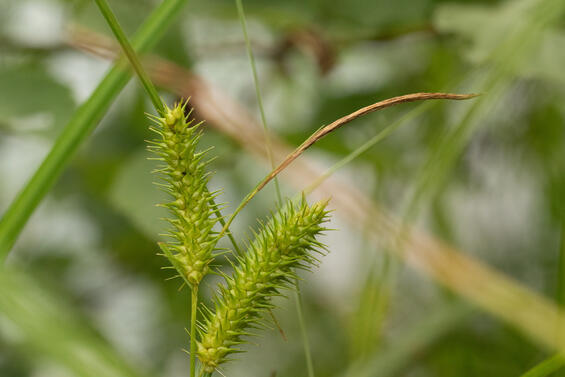
In fruit (photo credit: Cole Winstanley)
Bailey’s sedge (Carex baileyi), a member of the sedge family (Cyperaceae), is a perennial, herbaceous, grass-like plant of freshwater wetlands and moist woodlands. It was named in honor of botanist Liberty Hyde Bailey (1858-1954). It occurs in dense clumps, often in association with other wetland sedges and grasses under a forest canopy with some filtered light. To positively identify Bailey’s sedge and other members of the genus Carex, a technical manual should be consulted. Species in this genus have tiny, wind-pollinated flowers that are borne in spikes. Each flower is unisexual, and is closely subtended by small, flat scales that largely conceal the flowers. The staminate (i.e., pollen-bearing) flowers are subtended by a single scale. The pistillate (i.e., ovule-bearing) flowers are subtended by two scales, an outer flat scale (“pistillate scale”) and an inner, sac-like scale, called a “perigynium,” that encloses the flower, and later, the achene (fruit).
Bailey’s sedge grows in clumps of many sharply-angled stems 20-70 cm (8-28 in) tall with a purplish-red base. It belongs to a group of sedges in section Vesicariae, which all have three-sided achenes topped by a bony, persistent style, and have at least slightly inflated perigynia. Bailey’s sedge is unique within this group in its combination of long-awned pistillate scales and very long perigynium beaks (analogous to the neck of a vase), which exceeds the length of the true perigynium bodies (analogous to the bottom portion of a vase). Leaves are 10-20 cm (4-8 in) long and quite narrow (2-4 mm, 0.1-0.2 in). The leaves overtop the inflorescence, which has a solitary terminal staminate spike and lateral carpellate spikes. The carpellate spikes are cylindrical and 9-14 mm (0.35-0.6 in) thick. The perigynia are 4.8-6.6 mm (0.19-0.26 in) long, with beaks usually as long as or longer than the body of the perigynia. The lowest bract subtending the inflorescence is leaf-like and is longer than the inflorescence. The achenes are 3-sided with minute bumps (papillae), 1.2-2 mm (0.05-0.08 in) long.
Bailey’s sedge closely resembles the much more common sallow sedge (Carex lurida) which is found in similar habitats. However, the beak length relative to the perigynium body length in the sallow sedge is shorter than that of Bailey’s sedge, i.e., typically only half to almost as long as the body of the perigynium. The sallow sedge is also usually taller, up to 1.1 m (3.5 ft), with heavier, more robust stems and broader leaves; the widest leaves are 4.5-13 mm (0.2-0.5 in) wide. The pistillate spike in the sallow sedge is 1.4-2.0 cm (0.6 to 0.8 in) in diameter, wider than that of Bailey’s sedge.
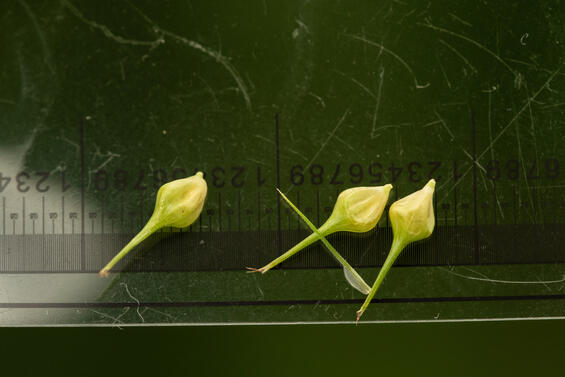
Perigynia with metric scale (photo credit: Cole Winstanley)
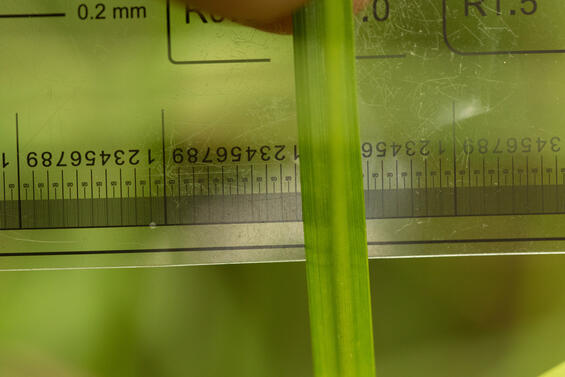
Narrow leaves with metric scale (photo credit: Cole Winstanley)
Life cycle and behavior
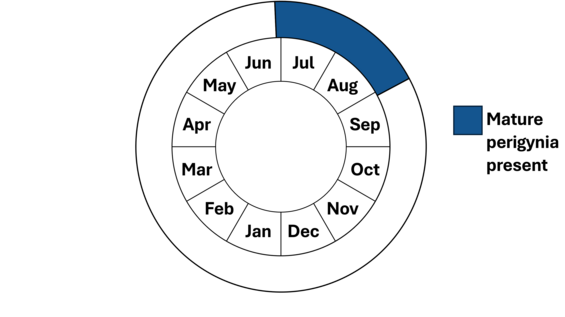
Bailey’s sedge is a perennial, clumping sedge that is wind-pollinated. It blooms early in the season and has mature perigynia (needed for identification) from July through August.
Population status
Bailey’s sedge is listed under the Massachusetts Endangered Species Act as threatened. All listed species are protected from killing, collecting, possessing, or sale and from activities that would destroy habitat and thus directly or indirectly cause mortality or disrupt critical behaviors. There are currently 23 occurrences in the state verified since 1999 for Bailey’s sedge, and three historical occurrences, all of which are located in western Massachusetts, in Berkshire, Franklin, and Hampshire Counties.
Distribution and abundance
Bailey’s sedge is restricted to the Appalachian region of North America. It extends from southwestern Quebec southward to North Carolina and Tennessee in the south. In New England, Bailey’s sedge is also listed as rare in the states of New Hampshire and Maine (presumed extirpated). It is not known from Connecticut or Rhode Island. It is also rare in North Carolina, Ohio and Quebec, and considered secure in the center part of its range.
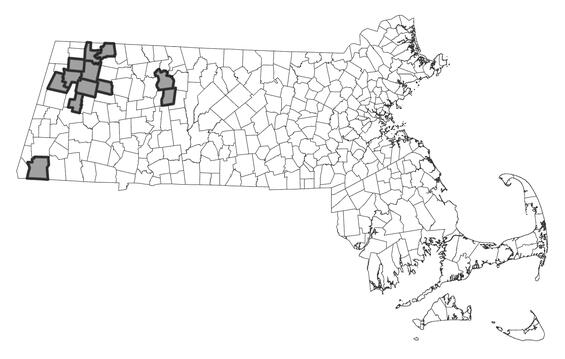
Distribution in Massachusetts
2000-2025
Based on records in the Natural Heritage Database
Habitat
In general, this species is found in swampy areas, including sedge meadows, seeps, ditches, and shrub wetlands. Specific habitats in Massachusetts include a wet ditch, a wooded roadside, a rut in an abandoned woods road, a steep stream bank, a wooded swamp, and a wet, shrubby woodland. Herbaceous species observed in association with Bailey’s sedge include manna-grass (Glyceria spp.), New York fern (Amauropelta noveboracensis), rough-stemmed goldenrod (Solidago rugosa), whorled wood aster (Eurybia divaricata), turtlehead (Chelone glabra), Joe-Pye-Weed (Eupatorium maculatum) and rough bedstraw (Galium asprellum). Woody species observed with Bailey’s sedge include sugar maple (Acer saccharum), black birch (Betula lenta), yellow birch (Betula alleghaniensis), balsam fir (Abies balsamea), red spruce (Picea rubens), witch hazel (Hamamelis virginiana) and several species of willow (Salix spp.).
Healthy habitats are vital for supporting native wildlife and plants. Explore habitats and learn about conservation and restoration in Massachusetts.
Threats
Bailey’s sedge is threatened by rights-of-way maintenance, logging, succession, hydrological alterations and invasive species. Rights-of-way maintenance can change from a threat to a benefit if specific actions are taken by utility companies. This change in management can be a means to protect and perpetuate the species.
Conservation
Survey and monitoring
Surveys for Bailey’s sedge should be completed every five to ten years to determine if the habitat still supports the population or if there have been changes. It is important that the surveyor note what the threats are to the species at each location. The best time to survey for the species is from July through September, when there are mature perigynia. As this species is easily confused with sallow sedge, photographs with a metric ruler are preferred that show the narrower leaves and inflorescence of Bailey’s sedge.
Management
All active management of rare plant populations (including invasive species removal) is subject to review under the Massachusetts Endangered Species Act and should be planned in close consultation with the MassWildlife’s Natural Heritage & Endangered Species Program.
Little is known about the specific requirements of Bailey’s sedge, but observations of existing populations suggest it may be tolerant of moderate disturbance. Nevertheless, drastic alteration of soils, hydrology, or the forest canopy would likely have negative impacts on a population. Selective thinning of the forest canopy to prevent excess shading may improve the health of populations although the results of such manipulations should be monitored closely. Invasive plant control may also be needed in places; such work would need to proceed carefully with a plan to avoid accidental injury to Bailey’s sedge.
Research needs
In Massachusetts, Bailey’s sedge has characteristics similar to sallow sedge and some genetic work was done that indicated the two species are closely related. Additional work on their genetic relationship to each other is needed. In addition, work on the tolerance of Bailey’s sedge to shading and disturbance is needed.
References
Arsenault, Matt, Glen H. Mittelhauser, Don Cameron, Alison C. Dibble, Arthur Haines, Sally C. Rooney, and Jill E. Weber. 2013. Sedges of Maine, A Field Guild to Cyperaceae. University of Maine Press, Orono, Maine.
Gleason, Henry A., and Arthur Cronquist. Manual of Vascular Plants of Northeastern United States and Adjacent Canada, Second Edition. Bronx, NY: The New York Botanical Garden, 1991.
Haines, Arthur. Flora Novae Angliae. New England Wild Flower Society, Yale University Press, New Haven, CT. 2011.
Native Plant Trust. 2014. NORM Phenology Information.
NatureServe. 2025. NatureServe Network Biodiversity Location Data accessed through NatureServe Explorer [web application]. NatureServe, Arlington, Virginia. Available https://explorer.natureserve.org/. Accessed: 3/6/2025.
POWO (2025). "Plants of the World Online. Facilitated by the Royal Botanic Gardens, Kew. Published on the Internet; https://powo.science.kew.org/ Retrieved 3/6/2025."
Weakley, A.S. 2020. Flora of the southeastern United States. University of North Carolina Herbarium, North Carolina Botanical Garden, Chapel Hill, NC.
Contact
| Date published: | March 25, 2025 |
|---|